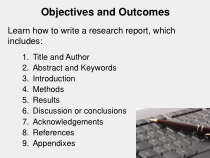 PPT
PPT
【文档说明】技术与商务交流英语第二版课件Chapter15ResearchReport.pptx,共(99)页,381.584 KB,由小喜鸽上传
转载请保留链接:https://www.ichengzhen.cn/view-158876.html
以下为本文档部分文字说明:
ObjectivesandOutcomesLearnhowtowritearesearchreport,whichincludes:1.TitleandAuthor2.AbstractandKeywords3.Introduction4.Methods5.Results6.Discussio
norconclusions7.Acknowledgements8.References9.AppendixesOverviewAresearchreportisapaperwrittenbyaresearcherorresearcherstodescribeast
udythathasbeencompleted.Thepurposeofthereportistoexplaintootherstheobjectives,methods,andfindingsofthestudy.Thedissertationorgraduationthesistha
tyouaregoingtowritebelongstothiskindofwriting.Therefore,youneedtolearnhowtowritetheresearchreport.Theorganizationalformatforallresearchreportsis
basicallythesame,regardlessofthefieldofstudyinwhichtheauthorisworking.1.TitleandAuthor2.AbstractandKeywords3.Intr
oduction4.Methods5.Results6.Discussion/Conclusions7.Acknowledgements(optional)8.References9.Appendixes(optional)I.TitleandAut
hor1.IncludeAllKeyInformationintheTitleThetitleofaresearchpapershouldbe:•consistentwiththecontentsofthearticle;•highlyreprese
ntativeofthecentralideaofthepaper.Thetitlegenerallyincludesinformationonthefollowingaspects.Informationelementsinthetitle:
•Theindependentanddependentvariablesinvolved相关的自变量和因变量:medicine&patients;price&sales•Thesubjects研究对象:customers;patients;animals•Theconditionofsubject
s条件•Theexperimentalapproach研究方法Practice:Readthefollowingtitlesandtellwhatinformationelementsareineachtitle.(1)Effectso
fCross-borderE-commerceonPettyCommoditySalesfromSmallFactoriesinYiwu•(independentvariable+dependentvariable+condition)•跨
境电商对义乌小企业小商品销量的影响(2)ApplicationofCooperationPrinciplestoEnglishforBusinessCommunication•(approach+subjects+condi
tions)•合作原则在商务英语中的应用(3)MicrovascularPressuresMeasuredbyMicropunctureinLungsofNewbornInfants•(variables+
approach+conditions+subjects)•使用微刺法对新生儿肺中微脉管压的测量2.MaketheTitleConcreteinMeaning•Makesurethatthetitlecontainsalltheinformationrelevant
toyourreaders.•Usespecificwordstoexpressthemeaningofthetitleconcretely.•Keepthekeywordsinthetitleforpaperretrieval.•Title
sthataretoogeneralcancausedifficultiesinon-linesearching.Comparethefollowingpairsofexamplesandseethedifferenc
es.Example1:(1)ResearchintoComputerPrices•(toogeneral)•电脑价格研究(2)ComputerPricesinRelationtoItsSalesinBeijingAreasintheLastFiveYears•(independent
variable+dependentvariable+condition)(concrete)•近五年北京地区电脑价格与其销量的关系Example2:(1)AntibioticTreatmentofResp
iratoryInfections•(toogeneral)•对上呼吸感染的抗生素治疗(1)EfficacyofGatifloxacinandMoxifloxacininSinusitisinAdults•(concrete)•莫西沙星治
疗成人上呼吸道感染的功效3.AvoidWastingWordsIfatitleistoolong,itwouldbedifficultforreaderstocatchthemeaningofthecontentandrem
emberit.Tobebriefandconcise,omitthephrasesthatdonotexpresssubstantialmeaninginthetitle.E.g.•inthetreatmentof•studieson•repo
rtofacaseof•investigationon•somethoughtson•aresearchofExamples:(1)StudiesontheEfficacyofGatifloxacinandMoxifloxacininSinusitisinAdults
:aMulticenter,RandomizedDouble-blindTrial•(redundant)•对加替沙星和莫西沙星治疗成人鼻窦炎的功效的研究:一项多中心的双盲法随机试验。(2)GatifloxacinandMoxifloxacininSinusitisinAdults:aMultic
enterDouble-blindTrial.•(concise)•加替沙星和莫西沙星对鼻窦炎的疗效:一项多中心的双盲法试验Titlesofexperimentalresearchreportsareusuallyintheformofnounphrases,butnotins
entencesorquestions.Thisisbecausesentencesalwayscontainwordsofgrammaticalfunctionsandpunctuations(Whendoes…?Shouldthe…?Isthere…
?),whichmaketitlesredundant.4.AvoidAbbreviationsinTitlesMostjournalswillnotallowanyabbreviationsinthetitleexceptthosefo
rInternationalSystemofUnitsofmeasurement(SIunits国际单位制).E.g.IBM:(InternationalBusinessMachines;Internationalballisticmissile)•Abbreviationscou
ldleadtothepaperbeingmissedinon-linesearches.•Theycanbeconfusingtoreadersunfamiliarwiththesubject.5.AuthorTherearetwore
asonsforidentifyingwhatauthororgroupconductedtheresearch.•Correspondence:Readerswouldknowwhomtocallwithquestions.•CelebrityandResponsibility:Thepa
perpublicationisregardedasanormforvaluingtheprofessionalleveloftheresearcherandtheinstitutionconcerned.Ifanyconsequencesho
uldarisefromthepublicationofthepaper,itistheauthorthattakestheresponsibilityforit.Theprofessionaltitle,administrativerankoracademicde
greesuchas“Professor”,“ChiefManager”,or“Doctor”,etc,arepreferablyomittedbeforethenameofanauthor.Iftheremus
tbeatitleincluded,itcanbeputwithacommaafterthename.Forexample:HaipingWang,ProfessorDepartmentofBiochemistry,BeifangUniversityBe
ijing,100871,thePeople’sRepublicofChinaDifferentjournalsmayhavedifferentrequirementsontheformatofthetitleandaut
hor.II.AbstractandKeywords1.Abstract•Goodabstractshelpthereaderdecidewhethertoreadareportentirelyandfac
ilitatethereadingofthereport.•Thetypeofabstractusedinresearchreportsistheinformativeabstract.•RefertoUnit14fordetailso
ftheinformativeabstract.2.KeywordsKeywordsarethemostimportantwordsandphrasesrepresentativeofthethemeoftheresearchreportandfr
equentlyusedinthepaper.关键词是代表研究报告主题的最重要的词语。Thefunctionofkeywordsistofacilitatetheinformationretrievalandemphasizethegistofthepaper.关键词的作用
是有利于信息检索和强调文章要点。Thekeywordsofapaperusuallycomefromthetitleandtheabstract.关键词通常来源于标题和摘要。Keywordsshouldbespec
ificinmeaning.Avoidusingwordsthataretoogeneralinmeaning(suchasstudy,research,investigation)askeywordsbecausetheymayca
usedifficultyininformationretrieval.Keywordsareusuallyintheformofnouns,notverbs,adverbsoradjectives.Forexample,use“in
filtration”insteadof“infiltrate”;“education”insteadof“educate”.Thenumberofkeywordsislimitedaccordingtotherequire
mentofthejournal.Majorsectionsoftheresearchreport:➢Introduction➢Methods➢Results➢Discussion/ConclusionsT
hemajorsectionsformthebodyoftheresearchreport.Ⅲ.IntroductionTheintroductionisthefirstmajorsectionoftheresearchreport.
Itservesasadirectiontoreaders,givingthemtheoutlooktheyneedtounderstandthedetailedinformationcominginlatersections.Thein
troductiongenerallyconsistsoffivepartsinsequence.1.Background:Generalstatementsaboutafieldofresearchtoprovidethereaderwithasettingforthe
problemtobereported2.Literaturereview:Morespecificstatementsabouttheaspectsoftheproblemalreadystudiedbyotherresearchers3.Re
searchquestion:Statementsindicatingthespecificsubareathatneedstobefurtherinvestigated4.Purpose:Specificst
atementsgivingthepurposesorobjectivesofthestudy5.Value:Statementsprovidingajustificationforconductingthe
study.(Optional)1.BackgroundThebackgroundoftheintroductionprovidesreaderswiththeparticulartopicofyourresearchinrelationtoageneralareaofstudy.Itfollow
safunneltypeofdescriptioninthreesteps:(1)Beginwithacceptedstatementsoffactsrelatedtoyourgeneralarea.(2)Withintheg
eneralarea,identifyonesubareathatincludesyourtopic.(3)Indicateyourtopic.GeneralareaFreshwaterisafundamentalrequirementinourdailylives.Asthewor
ldpopulationandindustrialpollutionincrease,ithasbecomequiteclearthattheearth’soncebountifulresourcesaredwindling.However,water,oneofthemostpreciou
sofresources,canbeendlesslyrecycled.Sub-areaThereareseveralmethodsthatcanbeusedtotreatandrecyclewaste-water.Someofthe
mostintriguingincludeusingplantlifetocleansewateraswellasprovidefoodsourceforanimalsorotherformsofener
gy.TopicSeveralwater-plantsarebeinginvestigated,butduckweed,averyuniquetypeofwater-plant,maybeveryusefulinrecyclingwaste-water.Example1:W
aste-watertreatmentbyusingduckweed2.LiteratureReviewAfterintroducingthetopicofyourstudyinthepartofthebackground,youneedtoexplainthepresentsitu
ationofthestudyonthistopic.Theliteraturereviewisalooking-backonthefindingsbyotherresearchersthathavebee
npublishedinyourfieldofstudy.Literaturereviewhasthreefunctions:•Providingthebackgroundinformationneededtounderstandyo
urstudy.•Demonstratingyourfamiliaritywiththeimportantresearchthathasbeencarriedoutinyourarea.•Establishingyourstudyasonelinkin
achainofresearchesinyourfieldandbuildingcredibilityforyourresearchbyshowingthatyourstudyisdirectlyconnectedtoacceptedre
searchdonepreviously.Inliteraturereview,youneedtoincorporatetheideasfromothersinyourwriting.Dependingondifferentpurposesandcontent,citationsin
aliteraturereviewcanbearrangedinseveraldifferentways.•OrderofCitations•VerbTenseinCitations1.OrderofCitationsYoucanarrangeth
eminorderfromgeneraltospecific—thatis,fromthosemostdistantlyrelatedtoyourstudytothosemostcloselyrelatedtoit,asinexample1.Inaliter
aturereviewdescribingthehistoryofresearchinanarea,youmayarrangeyourcitationsinchronologicalorder—whatha
ppenedfirstismentionedfirst,asinexample2.Ifyouhavealargenumberofcitationstoincludeinyourliteraturereview,youcangroup
themaccordingtothedifferentapproachestotheresearchproblemtakenbydifferentauthors.Thecitationswithineachgroupcanthenbeorderedchronolo
gicallyorfromgeneraltospecific,asinexample3.MosteducatorsinChinaseemtoagreethatthemicrocomputerwillplayanimportantroleinteach
ing.Wang(1994)andTaylor(1990)predictedasignificantincreaseinthenumberofcomputersinbothschoolsandhomesinthenearfuture.Stickel(1992)identifiedth
reetypesofmicrocomputeruseinclassrooms:astheobjectofacourse,asasupporttool,andasameansofprovidinginstruction.LiandHuang(1995)reportedfouruse
sofmicrocomputersinteachingmedicine:drillandpractice,tutorial,simulation,andproblemsolving.Example1Citati
onsArrangedintheOrderfromGeneraltoSpecificThestudyofconsumercomplainingbehaviorhasprogressedsteadilyovertheyears.BarnumandLevinson(
1996)foundthatdissatisfiedconsumerschoosetoseekredress,engageinnegativeword-of-mouthbehavior,orexitbasedupontheperceivedlikelihoodofsuccessfulr
edress;FraserandBrown(2000)reportedthatdissatisfiedconsumers’reactionsarebasedupontheirattitudetowardcompl
aining;Gerson(2004)statedthattheirreactionsarebasedupontheinvariabilityandcontrollabilityoftheproblem;andHoupandLannon(2005)discoveredthattheirreacti
onsarebaseduponthelevelofproductimportance.Consumerswhoaredissatisfiedwithaproductthattheyfeelisimportantaremorelikelytos
eekredress(Pattow2010).Example2CitationsinChronologicalOrderTheCETisestablishedonthetesttheoriesofstructuralism(Liu2003
:131),whichdivideslanguageintodiscretepointsandteststhemintheformofmultiple-choicequestions.Itsadvantagesareits
convenienceformachinegrading,itsobjectiveness,anditswidecoverageoflanguageknowledge.However,thediscrete-pointtestviewslanguageabilityasadis
cretesystem(Li2002:34),andthusdivideslanguageintoseparatelanguagepoints,suchasgrammarandvocabulary,andteststhemsep
arately.Theproblemisthatlanguageincommunicationisinasyntheticformsincephonetics,grammar,andvocabularyareintegratedasawhole.Therefore,byfocusingonte
stingstudents’receptiveabilitywhileneglectingtheirproductiveability,themultiple-choicetestcannotreflectstudents’communi
cativecompetenceobjectively(Hanetal.2004:18).Example3CitationsArrangedAccordingtoDifferentAspectsoftheIssue2.VerbTensesinCit
ations.Beginnerswillfinditisdifficulttodecidethetenseofcitations.Thetensechoiceofcitationsisrelatedtothefocusofthecitationinthesentenceinthreeways:•
Informationprominent•Weakauthorprominent•Authorprominent(1)InformationprominentWhenthefocusofyourcitationisontheinformation,y
oushouldwritethecitationinthepresenttense.Thepresenttenseisusedwhentheinformationyouarecitingisgenerallyacceptedasfact.E.g.①TheCETis
basicallyestablishedonthetesttheoriesofstructuralism结构主义测试理论(Liu2003:131).②Consumerswhoaredissatisfiedwithaproductthatthe
yfeelisimportantaremorelikelytoseekredress(Pattow2010).对产品不满意的消费者如果认为该产品很重要,则更有可能寻求赔偿。(2)WeakauthorprominentWhenthe
focusofyourcitationisontheresearchareaofseveralauthors,youshouldusethepresentperfecttenseinthesentence.E
.g.③Quiteafewinvestigatorshavestudiedtheconsumercomplainingbehaviorovertheyears(Pattow2010;HoupandLannon2005;G
erson2004;FraserandBrown2000).④Severalresearchershavestudiedtherelationshipbetweenspiralbacteriaandgastritis螺旋菌与胃炎的关系(Andrews1
996;Nicholson1994,Taylor1989;Howren1985).(3)AuthorprominentWhenthefocusofyourcitationisontheauthor,thatis,when
youusethenameoftheauthorasthesubjectofthesentence,youshouldusethesimplepasttenseinitspredicate.E.g.⑤FraserandBrown(2000)re
portedthatdissatisfiedconsumers’reactionsarebasedontheirattitudestowardcomplaining.⑥Stickel(1992)statedthattherewerethreetypesofmic
rocomputeruseinclassrooms.Tensesinsubordinateclauses:Althoughthesimplepasttenseisusedinthemainclauseoftheauthorprominentsentences,thetensesusedint
heobjectclausetoreportthefindingsaredifferent.•Ifthefindingsofthestudyaregenerallyacceptedasfact,presenttenseisused(E.g.5).•Ifthefinding
softhestudyarelimitedtothatstudybutnotacceptedastrueinallcases,pasttenseisadopted(E.g.6).3.ResearchQuestionThepurpose
ofresearchquestionistosumuptheliteraturereviewandpointoutasubareathatisnottreatedinthepreviousliterature,butthati
simportantfromviewofyourwork.Usuallythispartisaccomplishedinonlyoneortwosentences.Therearethreealternativesyoucanchoosefrominsta
tingyourresearchquestion.(1)Indicatingthatthepreviousliteratureisinadequatebecauseanimportantaspectoftheresearchareahasbeenignoredbyotherauthors.Exam
ple:Manydemographicfactorsaffectingfood-buyingdecisions,includingage,education,incomeandexperience,havebeenstudied.Ho
wever,religionisaspecializedfactoraboutwhichlittleisknown.(2)Indicatingthatthereisanunresolvedconflictamongtheauthorsofpreviousstudiescon
cerningtheresearchtopic.Example:StudiesbyJackson(1985)andTaylor(1992)indicatedsuperiorresultswiththecommunicativeapproach
whilestudiesbyEllis(1983),Howren(1990)andKemble(1994)indicatedlittleornosignificanteffect.Therefore,morestudiesneedtobeconducted
toascertaintheeffectsofthecommunicativeapproachinteachingvarioussubjectsinavarietyoflearningsituations.(3)Indicatingthatanexaminationo
fthepreviousliteraturesuggestsanextensionofthetopic,orraisesanewdirectionnotpreviouslystudiedbyothersinyourfi
eld.Example:Whilemostoftheliteratureonbusinessriskandriskresponsetreatsonlyproductionandpricerisk,wei
ntendtointroducethenotionoffinancialriskintothedecision-makingprocess.Theresearchquestiongenerallyconsistsofthreeparts:Signal
WordMissingInformationResearchTopicHowever,littleinformationisavailableonfinancialriskinthedecision-m
akingprocess.Butfewstudieshavereportedontheeffectsofthecognitivestrategytraininginlanguagelearning.4.PurposeThestat
ementofpurposefollowstheresearchquestiondirectly.Itanswerstheneedexpressedinthequestionforadditionalresearchinyourareaofstudy.Youmaywriteth
estatementofpurposefromoneofthefollowingtwoorientations:•theperspectiveofthereportitself;•theperspectiveoftheresearchactivity.(1)TheRepo
rtPerspectiveInthereportperspective,thepaperorreportservesasthesubject(orpartofthesubject)ofthesentence.Thepresentorfuturetenseisus
uallyusedinthiskindofstatement.E.g.•Thepurposeofthispaperistodeterminewhetherthecognitivestrategytrainingcanimprovestudents’learningabili
ty.•Thisthesiswilldealwiththeimplementationandoperationofanautomaticmeasurementsystemappropriateforcl
assroomandlaboratorydemonstrations.(2)TheResearchPerspectiveIntheresearchperspective,thestatementofpurposer
eferstotheresearchactivityratherthanthereport.Thepasttenseisusuallyusedinthiskindofstatement.E.g.•Theobjectiveofthisresearchwastog
ivethemostdirectanswerpossibletothequestionofhowlongadvertisingaffectssales.•Theaimofourexperimentwastodetermineifanimperfectlis
teningtypewriterwouldbeusefulforcomposingletters.5.ValueThestatementofvaluejustifiesyourresearchonthebasisofitspotentialbenefitorsignificancetoot
herresearchersinthefieldortopeopleworkinginpracticalsituations.Itcanbewrittenfromtwoalternativeperspectives:valueinpracticeorvalueintheory
.Youmaywritethestatementfromtheperspectiveofthepracticalbenefitsthatmayresultfromapplyingthefindingsofyourresearch.
•Theresultsofthisstudycouldbeusefultoeducatorsresponsibleforplanningcourseworkinforeignlanguageeducation.•Thisresearchmayprovideanaltern
ativeapproachtoperformingdelicatebrainsurgery.Youmaywriteastatementofvaluethatemphasizesthetheoreticalimportanceofyourstudy.Inthisway,youcontribute
totheknowledgeinyourspecificareaofresearch.•Bothofthefactorsunderinvestigationinthisstudymaybeofimportanceinexplainingtheetiolo
gyofthisdisease.•Theresultsofthisstudymaysuggestaneedforabroaderhypothesisforfurtherresearchintothegreen-houseeffectontheenviron
ment.Thestatementofvalueshouldbewrittenwithtentativenessormodestyonthepartoftheauthor.Usemodalauxiliari
es,suchas“may”or“could”,asisshownintheaboveexamples.Thestatementofvalue,however,isnotincludedineveryintroduction.
Itisusuallyincludedinstudents’theses,dissertations专题(学位)论文,orthesisproposals论文开题报告.Itisalsocommonlyusedinresearchreportswrittentodescribea
projectfundedbyoutsidesources.Ⅳ.MethodThemethodsectionmainlydescribestheprocedureyoufollowedinconductingyourresearchandthemater
ialsyouusedateachstep.Ifthereaderswanttoknowhowthemethodsofyourresearchmayhaveinfluencedyourresults,oriftheyareinterestedinreplicatingyourresearch,th
eymustexamineyourmethodcarefully.Thusthissectionisusuallylongandindetail.1.InformationElementsThemainpartsofthemethodsectionar
eproceduresandmaterials,whichdescribesthestepsusedinyourstudyandthematerialsemployedateachstep.However,otherelements
arealsocommonlydescribedinthissection.Thefollowinglistpresentsthecommonelementsinthemethodsection.AListofElementsintheMethodSection•OverviewoftheRese
arch/StudyDesign(E.g.descriptiveorexperimentalresearch,qualitativeorquantitativeanalysis,casestudy,trendstudy.SeeAppendix1)•SubjectsorSamples(
people,animals,things)•SamplingTechnique(E.g.randomsampling;systematicsampling)•Procedures(stepsinconductingtheresearch
)•Materials(equipment,substance,teachingmaterialsandexampapers,questionnaire,interviewquestions,etc.)
•RestrictionsorLimitingConditions(E.g.below10oC)•StatisticalTreatment(methodsofcalculation,E.g.SPSS)Exam
ple:InformationElementsinaMethodSectionResearchOverviewThestudywasconductedasathree-groupcontrolledexperiment
followingthestatic-groupcomparisondesign.Itinvolvedtheuseofthreeexperimentalgroups,includingGroupA,acontrolgroup;GroupB,atreatment
groupconsistingofbeginner-levelmicrocomputerusers;andGroupC,atreatmentgroupconsistingofintermediate-levelmicrocomputeru
sers.SamplingtechniqueTherandomsamplingoftheparticipantswasconductedthattheparticipantsrepresentedasampleofstudentsinfinancialeducation.Therefore
,thefindingsandimplicationsofthestudyshouldbegeneralizedtotheextentthatfuturegroupsofstudentsaresimilartotheparticipants.Population(Subjects)
The30studentsdesignatedasthecontrolgroupweretaughtusingalecture-discussiontechnique.Theother60studentsweredividedintotwotreat
mentgroupstoreceivemicrocomputer-assistedinstruction.Studentswiththeabilitytorunandeditsoftwareprogramswereassignedtotheint
ermediate-levelgroup,andtheremainingstudentswereassignedtothebeginnersgroup.ProceduresTheclassescomprisingthecontrolgroupwereorganiz
edintotwo-hourclasssessionsinthreeconsecutivedays.Thewrittenevaluationwasgivenduringthefirsthourofthefourthday.Thetreatmentgroupsweregiventhre
edaystocompletethetask,wereaskedtokeeparecordoftheamountoftimeused,andweregiventhewrittenevaluationduringaone-hourtimeperiodofthefourthday.
MaterialsThematerialsusedinteachingexportquotationandcontractwiththelecture-discussionmethodwerethebasisforwritin
gacomputerteachingprogram.StatisticalTreatmentNullhypothesesweredevelopedtotesttheresearchquestionsofthestudy.Analphalevelof.05wasusedintestingtheh
ypotheses.APearsoncorrelationcoefficientwasusedtoascertaintherelationshipbetweentimespentonmicrocomputer-as
sistedinstructionandstudentperformance.ThedatawereanalyzedwiththestandardstatisticalanalysissystemSPSS
.2.ChoiceofVerbTensesThemethodsyouusedincarryingoutyourstudyareusuallywritteninthesimplepasttense.However,ifyourstatemen
tisagenerallyacceptedfactortruth,itshouldbewritteninpresenttense.Examples:•Thoseinterviewedinthestudywere18Chinese-speakingstudentsattendingclasses
attheUniversityofPortsmouth.(specificreference)•AllstudentswhoapplyforadmissiontotheUniversityofPortsmouthtaketheIELTSTest.(generalreference)Ify
ouuseequipmentinyourstudywhichisconventionalinyourfieldandfamiliartomostresearchers,youshoulddescribeitwiththepresentt
ense.Examples:•Atypicalrefrigeratorincludesacompressor,acondenserandanevaporator.典型的冰箱包括一个压缩机、一个冷凝器和一个蒸发器。•Theheateressenti
allyconsistsofabundleofparalleltubes,theendsofwhichexpandintotubesheets.加热器包括一束平行的管子,管子的末端伸入管板。Ifyouusespeciallydesignedmaterialswh
ichmaynotbefamiliartootherworkersinyourfield,youshoulddescribeitinthepasttense.Ifyoumodifiedacommondevicein
aspecialwayforyourstudy,youshouldalsodescribeitinthepasttense.Thefollowingareexamples:•Thesapofthemosaicdi
seasedtobaccoplantwasextractedbycrushingtheplantwithamincer,whichwasspecificallydesignedforthispurpose.•Thenewreactorw
asmoreheavilyequippedthantheothersfortestingpurposes.Morecadmiumrodswereinstalledinordertobeintroduced
intocavitiesinthereactortoarrestreactionsbyabsorbingneutrons.Thiswastopreventthereactorbecomingunstable.Ⅴ.ResultsTheresultssectionisthe“core”
oftheresearchreport.Readersexpecttheresultstoprovidethemwithenoughdatatodrawtheirownconclusionsabouttheanswer
tothequestionposedintheintroduction.Thissectionpresentsthefindingsofthestudyinbothfiguresandtext:•Figures(tables,gra
phs,anddiagrams)presenttheresearchfindingsinnumericaltermsordata.•Thetextinterpretsthedataandhelpsthereadertofocusonthemostimportantaspectsof
theresults.1.InformationElementsTheresultssectionusuallyconsistsofthreekindsofinformation.(1)Locationofdata:statementsthatspecif
ythefigure(s)wheretheresultscanbefound.(2)Results:statementsthatexplainthemeaningofdataorotherfindings.(3)Interpretation:statementsthat
givereasonsforcertainresultsorexplaintheirsignificance.Example:MajorInformationElementsinResultsLocationofDataMeanscoresandgen
eralresultsofthetestfromeachofthethreegroupsarepresentedinTable1.2,andtheresultsoftheanalysisofvariancetestarereportedinTable1
.3.ResultsTheFvalueof8.17,reportedinTable1.3,indicatedasignificantdifferenceingroupmeanscores.TheresultoftheScheffetestshowedthattherewasasigni
ficantdifferencebetweenthecontrolgroupandeachoftheCAIgroups.TherewasnotasignificantdifferencefoundbetweenthetwoCAIgr
oups.Thetestscoresfromthecontrolgroupwerehigherthanthosefromeithertreatmentgroup.Interpreta-tionThesefindingsindicatethatt
helecture-discussionapproachwasmoreeffectivethanthecomputer-assistedinstruction(CAI)inteachingtheapplicationofprinciplesandc
onceptsoffinance.2.LocationofDataBeforedescribingthedataobtained,youshouldfirsttellthereaderwheretheyare.Thestatementofdatalocat
iontellswhichfigure(table,graph,ordiagram)containsthedatamentionedinthetext.Thepresenttenseshouldbeusedtolocatedataina
figure.E.g.•Resultsofthet-testsarepresentedinTable3.•Figure2summarizesthetestresultsoncontaminatedwaters.•Table5
presentsthedataforworkersholdingskilljobs.3.ResultsandDataResultsaredifferentfromdataalthoughweoftensimplyrefertodataasresults.•Dataarefac
tsinaformofnumbersobtainedfromexperimentsandobservations.•Resultsaregeneralstatementsthatinterpretdata.Ifdatastandalone,reader
smaynotunderstandthemeaningreflectedbythem.Thereforeresultsmustbestatedtoexplainthemeaningofthedata.Examplesshowingd
ifferencesbetweendataandresults(1)Inthe20controlsubjects,themeanrestingbloodpressurewas85±5(SD)mmHg.Inthe30tenni
splayers,themeanrestingbloodpressurewas94±3mmHg.(2)Themeanrestingbloodpressurewashigherinthe30tennisplayersthaninthe20co
ntrolsubjects[94±3(SD)vs.85±5mmHg,P<0.02].(3)Themeanrestingbloodpressurewas10%higherinthe30tennisplayersthaninthe20controlsubjects[94±3(S
D)vs.85±5mmHg,P<0.02].•E.g.(1)isastatementofdata.Itsimplygivesthedatawithnoresult,whichmakesreaderswonderaboutthemeaningofthecomparison.•E.
g.(2)isavaguestatementoftheresult.Itstatestheresult,presentsthedataaftertheresult,andaddsaPvaluetoprovideevidencet
hatthedifferencewasnotlikelytohaveoccurredbychance.However,itfailstopresentthedegreeofthedifferenceincomparison.•E.g.(3)isaspecificstatementofther
esult.Thestatement“was10%higher”givesaclearerideaofthedegreeofthedifferenceincomparisonthanE.g.(2).4.Type
sofResultsTherearegenerallythreedifferenttypesofresultsthatyoumayneedtoreport,dependingonthekindofstudyyouconduct
.•Comparison•Tendency•RelationshipButonethingisthesame—alwaysusingpasttenseinreportingresults.(1)ComparisonResultsofthistypei
nvolveacomparisonamonggroups,oftenoneormoreexperimentalgroupswithacontrolgroup.Inthesecasesthestatementsareoftenwrittenwithexpressionso
fcomparativeorsuperlativedegrees.•Meantimetorecoverywassignificantlyfasterinthetreatmentgroupthanintheplacebogroup(
6.5vs.14.1days,p<0.05).•Thehighestincidenceofhepatitiswasfoundamongpeopleinthenorthpartofthestate.(2)Tende
ncyResultsofthistypeshowthetendencyofavariabletofluctuateovertime.Toreportsuchresults,youshoulduseverbsandexp
ressionsofvariationinyourstatements.Thecommonlyusedsentencepatternisasfollows:Variable+VerborVerbPhraseofVariatio
n+TimePeriod变量+表示变化的动词+时间段Examplesshowingthetendency:•Theoilpricesshowedatendencytoincrease/decrease(ortendtoi
ncrease/decline)overthefive-yearperiod.•Theconcentrationofchlorineintheatmosphereincreased(ordecreased,orremain
constant)overtheperiodstudied.(3)RelationshipResultsofthistypeshowtherelationshipofonevariablewithano
ther,orrelationshipsamongvariables.Useverbsofcorrelationorassociationinreportingsuchresults.E.g.•Theoccurrenceoftheepidemicwascorrela
tedwith(ornegativelycorrelatedwith,orassociatedwith,orrelatedto)thelocalclimate.•Therewasasignificantpositive(ornegative)relationshipbet
weenstudents’priorexperienceofthematerialandtheirtestscores.5.InterpretationofResultsAlthoughthemoregeneralcommentsonres
ultsarereservedforthesectionofdiscussion,itisoccasionallynecessaryforyoutoincludeabriefinterpretationofthestatisticalanalysis.Thissaveswo
rkforthereader,andhelpsthemtodistinguishthekeypointsinyourpaper.Wheninterpretingyourresults,younormallyusethepresenttenseandmodalauxilia
ries.Examples:•Thefindingthatbacteriawerepresentinalmostallpatientswithactivechronicgastritismaybeanimportantfactorintheetiologyofthe
disease.•Theseresultsindicatethate-commerceoffersdistinctadvantagesoverconventionalcommerceinthebookmarket.Youmayalsousetentativeverb
sinthepresenttenseinsteadofmodalauxiliariestogeneralizefromresults.Examples:•Itappears(seems,islikely)thatchildrenwhodisplay
learningproblemsaredependingononlyonecerebralhemisphere.•Theseresultssuggestthatthefinalpurifiedproteinintheformofac
rystalisjustthetobaccomosaicvirus.Wheninterpretingyourresults,youshouldchoose“provingwords”carefully.“Prove”isth
estrongestwordforyourfindings,butitcanrarelyusedunlessyouareabsolutelysureofyourfindings.Herearesomeothersindescendingorderofstrength.C
hoosetheonethatmatchesthestrengthofyourconclusions.•show•demonstrate•indicate•suggest•imply.Ⅵ.DiscussionThelastmajorsectionoftheresear
chreportisusuallytitleddiscussion(sometimescalled“conclusions”).Inthissection,youtakeabroadlookatyourfindingsandyourstudyasawho
le.Youtrytointerpretthefindingsbyanalyzingtheirfacts,underlyingcauses,effectsandimplicationsinamoregeneralview.1.Informatio
nElementsThekindsofinformationinthediscussionsectionarenotfixed.Itdependsmainlyonthefindingsofyourstudy.Youmayinclud
evariouselementsofinformation,dependingontheproblemsencountered,resultsobtained,possibleapplications,andfurtherresearchneeded.Theconventionalordero
fthissectionisfromspecificresultstogeneralimplications.Alistofconventionalelementsinthediscussionsection•Areferencetothepurposeorhypoth
esisofthestudy•AnanswertotheresearchquestiondevelopedintheIntroduction•Areviewofthemostimportantfindings,wh
etherornottheysupportyouroriginalhypothesis•Comparisonwiththeresultsofotherstudies•Possibleexplanationsfororspeculat
ionsaboutthefindings•Limitationsofthestudy•Implicationsofthestudy(intheoryorinpractice)•Recommendationsforfutureresearchandpracticalappl
icationsReadthefollowingdiscussionsectionfromaresearchreportinthefieldofeducation.Inthisstudytheteachingresultsofthetraditionallecture-dis
cussionapproachandthecomputer-assistedinstructionwerecompared.Noticetheinformationelementsthatareincludedinthisexampleandtheorderofinformation.Inform
ationElementsinaDiscussionSectionReferencetotheoriginalhypothesisWedevelopedfollowingnullhypothesestotesttheresearchquest
ionsofthestudy:1)therewouldbenosignificantdifferenceamonggroupmeanscores;2)therewouldbenosignificantrelationshipbetweentheamountoftimeutilized
bythestudentswithcomputer-assistedinstructionandstudents’testscores.AnswertotheresearchquestionThefindingsofourstudyindicatethatourfir
sthypothesiswasrejected;oursecondhypothesis,however,wasnotrejected.FindingssupportingtheanswerThefollowingconclusionsaresubjecttotheconditionsand
limitationsofthisstudy:(a)thelecture-discussionapproachwasmoreeffectivethanthecomputer-assistedinstructioninteachingtheapplicationofprinciplesandc
onceptsinmedicine;(b)theamountoftimespentbystudentssubjectedtothecomputer-assistedinstructiondidnotsignificantlyaffecttheirsc
oreswhengivenfreedomtoselecttheamountoftimespent.ExplanationforfindingsandcomparisonwithotherstudiesThefindingsindicatethatthelecture-d
iscussionmethodofteachingwasmoreeffectivethanthecomputer-assistedtechniqueinteaching.Thisconfirmstheearlierstudi
esbyJefferson,(1985),Gless(1987)andHowren(1988).Thepossibleexplanationisthatthestudentsinthecontrolgroupweretaughtmorepersonallyandsystemat
icallyduringregularhourswhilethetreatmentgroupsparticipatedduringlaboratorytimeattheirownsweetwill.Limi
tationsandcomparisonwithotherstudiesSincemanystudiesindicatedthatstudentsusingcomputer-assistedinstructionhave
generallyperformedaswellorbetterthanstudentsundertraditionallecture-discussioninstruction(Taylor1986,Horne1988&Clark
1989),thedifferenceinperformancefoundinthisstudyshouldbecarefullyevaluated.Thefindingsmighthavebeendifferenti
fallstudentshadspentaminimumof12hoursusingthecomputerprogram.Inaddition,themethodologicalproblemsintheresearchdesignlimitourint
erpretations.RecommendationforfurtherresearchFurtherstudiesshouldcomparegroupsusingamixoftraditionalinstructionan
dcomputer-assistedinstruction,andshouldrequireboththecontrolandthetreatmentgroupstospendaspecificamountoftimeontheteachingcourse
.Thechallengeformedicaleducatorsistobetterutilizethecapabilitiesofcomputer-assistedinstructioninthelearningenvironment.Referencetotheorig
inalhypothesisWedevelopedfollowingnullhypothesestotesttheresearchquestionsofthestudy:1)therewouldbenosigni
ficantdifferenceamonggroupmeanscores;2)therewouldbenosignificantrelationshipbetweentheamountoftimeutilizedbythestudentswithc
omputer-assistedinstructionandstudents’testscores.AnswertotheresearchquestionThefindingsofourstudyindicatethat
ourfirsthypothesiswasrejected;oursecondhypothesis,however,wasnotrejected.DiscussionfromUsingComputersi
nTeachingFindingssupportingtheanswerThefollowingconclusionsaresubjecttotheconditionsandlimitationsofthisstudy:(a)thelecture-discussionapproachwa
smoreeffectivethanthecomputer-assistedinstructioninteachingtheapplicationofprinciplesandconceptsoffinance;(b)th
eamountoftimespentbystudentssubjectedtothecomputer-assistedinstructiondidnotsignificantlyaffecttheirscoreswhengivenfreedomto
selecttheamountoftimespent.ExplanationforfindingsandcomparisonwithotherstudiesThefindingsindicatethatthelecture-discussionmethodofteachingwasmore
effectivethanthecomputer-assistedtechniqueinteaching.ThisconfirmstheearlierstudiesbyJefferson,(1985),Gless(19
87)andHowren(1988).Thepossibleexplanationisthatthestudentsinthecontrolgroupweretaughtmorepersonallyandsystematicallyduringregularhourswhilethetreatm
entgroupsparticipatedduringlaboratorytimeattheirownwill.LimitationsandcomparisonwithotherstudiesSincemanystu
diesindicatedthatstudentsusingcomputer-assistedinstructionhavegenerallyperformedaswellorbetterthanstudentsundertraditionallect
ure-discussioninstruction(Taylor1986,Horne1988&Clark1989),thedifferenceinperformancefoundinthisstudyshouldbe
carefullyevaluated.Thefindingsmighthavebeendifferentifallstudentshadspentaminimumof12hoursusingthecomput
erprogram.Inaddition,themethodologicalproblemsintheresearchdesignlimitourinterpretations.RecommendationforfurtherresearchFurtherst
udiesshouldcomparegroupsusingamixoftraditionalinstructionandcomputer-assistedinstruction,andshouldrequireboththecontrolandthe
treatmentgroupstospendaspecificamountoftimeontheteachingcourse.Thechallengeforeducatorsoffinanceistobetterutilizethecapabilitiesofcom
puter-assistedinstructioninthelearningenvironment.2.VerbTensesandSentencePatternsTheverbtensesusedinthediscussionse
ctiondependonthetypeofinformationyouwanttopresent.Thefollowingexamplesillustratethemostcommonlyusedtensesandsentencepatternsforeachkindofinf
ormationelementsinthissection.(1)Whenreferringtothepurposeorhypothesisofthestudy,youshouldusethesimpl
epasttense.E.g.•Thisresearchattemptedtoassesstheapplicationofcognitivestrategiesinteaching.•Inlinewiththehypothesis,weassumedthatphysicalde
crementswouldbemoreapparentinspeedjobsthaninskilljobs.•Itwasanticipatedthatcomputer-assistedinstructionwouldperformaswellasorbett
erthanlecture-discussioninstruction.(2)Inreviewingimportantfindings,youshouldusuallyusethesimplepasttense.E.g.•TheStudents’experi
encewiththemicrocomputerhadnoeffectontheirtestscores.•Thespiralbacilliwerepresentinalmostallpatientswithactivechronicgastritis,duodenalulcer,orgastri
culcer.(3)Inexplainingpossiblereasonsforthefindings,youmayusethepasttense,presenttense,ormodalverbsdependingontheconditionoftheexplanation.①Ifthe
explanationforthespecificfindingsisrestrictedtoyourstudy,usepasttense.E.g.•Itispossiblethatmicrobialactivitycausedsomeinfectionintherightlungoft
hepatients.•Itappearsthatthemicrocomputer-assistedlearningmoduleswereaseasyforthebeginnerstouseasfortheintermediate-levelusers
.②Ifitreferstoageneralcondition,youshouldchoosepresenttense.Youmayalsousemodalauxiliariestoemphasizethespeculati
venatureofthesestatements.E.g.•Theseresultscanbeexplainedbyassumingthatwomenaregenerallymorecarefulindelicateworkthanmen.•Onereasoncouldbeth
atskillsandexperienceincreasewithage.(4)Inexplainingthelimitationsofthefindings,youmayusethepasttense,presenttense,ormodal
auxiliaries,dependingonwhetherthelimitationisrestrictedtoyourstudy(past)orwhetheritreferstoageneralcondition(present).E.g.•Thesample
usedinourexperimentwasquitesmall.(restrictedtothestudy)•Theteachingexperimentsonothersubjectsmayproducedifferentresults.(generalcondition)(5)Inc
omparingyourfindingstothoseofotherresearchers,commonlyusethepresenttense.E.g.•Ourresultsareinsubstantialagreementwit
hthoseofGless(2001).•ThisconfirmsearlierfindingsbyTaylorandEble(1996)formedicalinsuranceintheUnitedSta
tes.(6)Inexplainingimplications,usethesimplepresenttense,modalauxiliaries,ortentativeverbs.E.g.•Itappearsthatthecurvedbacillibehaveasanimportan
tfactorintheetiologyofthesediseases.•Thisstudysuggeststhatmanagementbyobjectives(MBO)mayhaveafavorableimpactonperf
ormanceandsatisfactioninpublicsectoragencies.(7)Inexplainingrecommendationsandapplicationsofyourstudy,usethesimplepresenttenseandmodalauxi
liaries.E.g.•Theapproachoutlinedinthisstudyshouldbereplicatedinotherlaboratories.•Werecommendthatmoreforethoughtandplanningberequiredbeforethetra
iningreceivedindevelopedcountriescanbeoptimallyappliedinlessdevelopedcountries.•Clearly,thistechniquehaspromiseasatoolinevaluatingwaterqualities.
GuidelinesforVerbTensesinaResearchPaper:TensesApplicationsThepresenttenseGeneralconditionsGenerallyacceptedfactsThepastten
seStatementsrestrictedtotheresearchitself(purposes,methods,results)Thepresenttense(modalauxiliariesandtentativeverbs)In
terpretationofyourfindingsandyourstudyasawhole;(causes;reasons;comparison;limitation;implication;recommendation)VII.AcknowledgementsAcknowledgement
saremainlyusedtoexpresstheauthor’sindebtednesstothoseotherthanauthorswhohavehelpedintheresearchbyofferinga
nyusefulmaterials,specimen,technicalknow-how,suggestions,orfinancialaidtotheauthor.Thissectionusuallycons
istsoftwoparts:•Acknowledgementofpersonalorinstitutionalassistance•Acknowledgementoffinancialsupportfromdifferentsources1.AcknowledgementsofPersonala
ndInstitutionalAssistanceThefollowingareexamplesofacknowledgementstopersonalandinstitutionalassistance.The
arrangementusuallyfollowstheorderthatthosewhomadegreatercontributioncomebeforethosewhomadelesscontribution,andindividualsc
omebeforeinstitutions.•WearegratefultoDr.ZhangDongfortechnicalassistance.•Otherresearcherswhocontributedtothisstudywere:LiWeiping,MD,HeJian,MS,and
WangYun,MS.•TheauthorwishestoexpresshismostsincereappreciationtoProfessorZhaoMingyue,whoreadthemanuscriptcarefull
yandgavevaluableadvice.TremendousthanksareowedtoDr.LuYingforhelpingtheauthorwiththestatisticalanalysis.TheauthorisalsoindebtedtoBeijingFrie
ndshipHospitalforofferingsomespecimens.2.AcknowledgementstoFinancialSupportThefollowingareexamplesandcomm
onlyusedpatternsforacknowledgementstofinancialsupport.•ThisstudywassupportedbytheUnitedNationsEducational
,Scientific,andCulturalOrganization.•TheauthorisgratefultotheNationalNaturalScienceFoundationofChinaforitsfinancialsupportforthisproject.•Wethan
ktheNationalSocialScienceFoundationofChinaforprovidingthefinancialsupport.NotesonAcknowledgements:•Thewordingandexpressionsusedina
nacknowledgementshouldbeappropriate.Eitherunderstatementoroverstatementshouldbeavoided.•Itisadvisablenottomen
tiontoomanypersonswhohavemadeinsignificantorverygeneralhelptotheresearch.Forexample,typistsorillustratorsarenotmentioned.
•Theauthorshouldnotifytheaddresseeoftheacknowledgementandobtainhisorherpermissionbeforepublication.VIII.Re
ferencesAreferenceisanoteinaresearchreportreferringthereadertoanothersource.Thepurposesofreferencesinexperimentalresearchpapersaretogivec
redittotheideasandfindingsofothersandtodirectreaderstosourcesoffurtherinformation.Fordetailsofin-textcitationsandre
ferencelists,refertothesectionofDocumentingYourSourcesinChapter7.IX.AppendixesAppendixesareusedtoincludeinformationthatwouldbet
oolengthyorinterruptiveifplacedinthebodyofthereport.Theyaregenerallyfulltextsofquestionnaires,surveys,orotherdatacollectiondocum
entsusedintheresearch.Itistheusualpracticetosubmitappendixestothejournaltogetherwithyourreport,eventhroughtheywillnotbepublished.
Appendixescanhelpeditorsorreviewerstojudgewhetheryourfindingsarevalid.X.SummaryThemajorpartsofanexperimentalresearchreportwehavelearntinthi
sunit:•Title•Keywords•Introduction•Methods•Results•DiscussionorConclusionReview:•Informationelementsincludedineachpart•Orderoftheinformationel
ements•Commonlyusedsentencepatternsforeachelement•Commonlyusedvocabularyandthechoiceoftensesinthesentences
 辽公网安备 21102102000191号
辽公网安备 21102102000191号
 营业执照
营业执照